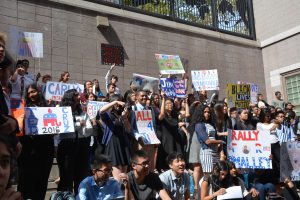
The Election Simulation is a Townsend Harris High School tradition where fresh-faced teens become politicians, and just like their political counterparts, do anything they can to get your vote. One of the goals of Simulation is to replicate real elections as closely as possible, which is why certain candidates have more money and team members than others. However, there are a few things that just cannot be represented accurately, given the demographics at our school. Eighty percent of the United States Congress is made up of Caucasian males. In a school with a student body that is 58% Asian American, it would be strange to expect all of the students playing a role to match the racial profiles of their respective candidates. Since students are allowed to play candidates of different racial backgrounds, why are students forbidden from playing candidates of opposite genders?

There once was a time when THHS was a male-only school, however, those days are long gone, as can be seen in an average classroom, where there are no more than a handful of boys. One would think that THHS would have adjusted with the times, but our school still falls embarrassingly behind. Females make up an overwhelming 71% of the student body, but with only two female candidates in the election, there must be a way to accommodate the disproportionate numbers.
Moreover, problems arise when choosing students to represent candidates because many males are reluctant to volunteer for the job. This is especially apparent this year, with twenty male candidates vying to become president. As a result, senior male students are often forced against their will to play candidates and are chosen at random. This is unfair to a male student who is shy or uncomfortable with public speaking. With not only his grade but his peers’ grades dependent on his effectiveness as a candidate, it is unfair to force a begrudging student into the spotlight.
The general consensus in a feature published in The Classic three years ago was that gender bending should not be allowed in the Election Simulation because it would fail to realistically reflect the actual election. Social Studies teacher, Dr. Linda Steinmann, was quoted saying, “It’s always been this way because the Election Simulation was designed to be gender specific. I guess it’s a tradition, and sometimes it’s not a good idea to mess with tradition.”
The official Election Simulation Teacher’s manual states, “the fundamental rule of the election simulation game is ‘keep it real!’” Yet, the reality is that the demographics of Townsend Harris clearly lean toward females. We stick steadfast to old traditions in the name of authenticity, but it’s time to be more open-minded.
Given the unbalanced ratio of boys to girls in our school, it is only logical to allow female students to play some male candidates.
There is no reason to resort to picking names out of hats when there are many girls eager to take on Election Simulation roles. In the current system, many girls miss the opportunity to develop public speaking skills and are deprived of the chance to lead their own campaign. They are employed as campaign managers or secretaries, but never get the chance to be the face of the campaign.
We don’t ask that the student playing Chris Christie gain 200 pounds or that the student playing Donald Trump get a spray tan in the interest of “keeping it real.” And we don’t have a “whites only” policy when it comes to matching white candidates with white students. So why would we impose gender inequalities on Election Simulation? It’s time to change the policy.


























